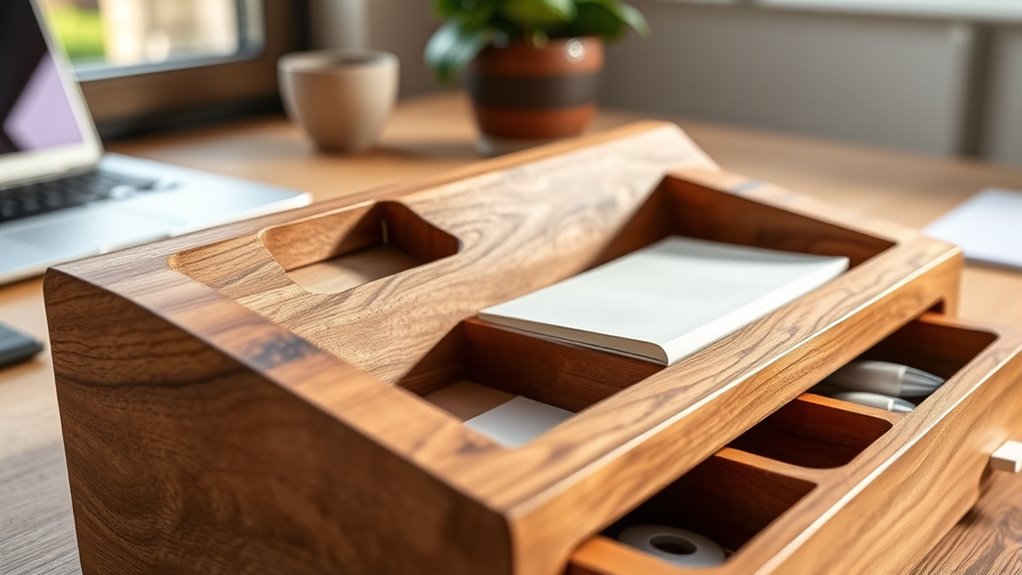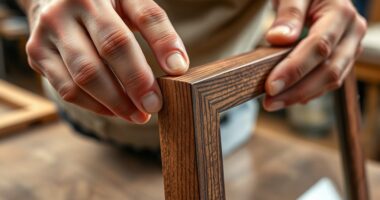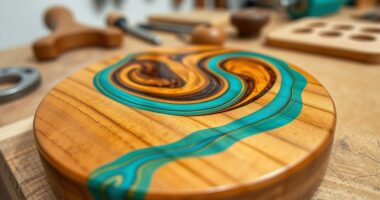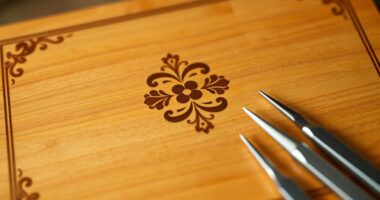To design a wooden desk organizer for your home office, choose high-quality, eco-friendly woods like maple or walnut that match your decor. Create compartments tailored to your essentials, such as pens, paperclips, or cables, ensuring they’re ergonomic and easy to access. Focus on smooth finishes and craftsmanship for durability and style. Properly organized and thoughtfully crafted, your desk will feel inviting and clutter-free—if you want to know more, keep exploring the detailed steps to perfect your design.
Key Takeaways
- Select eco-friendly, durable woods like maple or walnut with smooth finishes for safety and aesthetics.
- Design varied compartments tailored to specific office items, ensuring easy access and minimal clutter.
- Incorporate ergonomic features with appropriate heights and depths to promote comfortable use.
- Prioritize craftsmanship with seamless edges and well-finished surfaces for durability and visual appeal.
- Balance functionality and style to create an organized, inviting workspace that enhances productivity.

A well-designed wooden desk organizer can transform your workspace by keeping essentials neatly arranged and easily accessible. When you’re creating your own organizer, one of the first steps is paying close attention to material selection. Opt for high-quality woods like maple, oak, or walnut, which not only add a touch of elegance but also guarantee durability. The choice of wood impacts the overall look and feel of your organizer, so pick a material that complements your existing decor and withstands daily use. Smooth finishes and fine craftsmanship are essential, as rough or poorly sealed surfaces can be uncomfortable to handle and difficult to clean. Incorporating eco-friendly or sustainably sourced woods can also make your project more environmentally responsible, giving you peace of mind while enhancing your workspace.
Using vetted materials ensures your organizer remains durable and safe over time, providing peace of mind with your purchase or craft. As you plan your design, ergonomic considerations should be at the forefront. Your organizer needs to support your workflow comfortably and efficiently. Think about the height and depth of compartments to match the size of your most-used items—pens, paperclips, sticky notes, or charging cables—so you can grab what you need without straining or reaching awkwardly. For example, taller compartments are perfect for holding scissors or rulers, while shallow trays work well for small items like paper clips or thumbtacks. You should also consider the placement of compartments to minimize clutter and improve accessibility, ensuring that frequently used items are within easy reach. The edges and corners should be smoothly sanded to prevent any discomfort or accidental scratches, especially if you’ll be reaching across your desk often.
Designing with ergonomic considerations extends beyond just compartments. The overall height and layout should promote a natural, comfortable posture during use. For instance, avoid creating a bulky organizer that obstructs your view or crowd your workspace. Instead, aim for a balanced design that maximizes storage without overwhelming your surface. Incorporate features like angled sections or tiered levels to enhance visibility and ease of access. When you think about material selection and ergonomic design together, your wooden desk organizer becomes a functional piece that enhances productivity, reduces clutter, and adds aesthetic appeal to your home office. Taking the time to choose the right woods and thoughtful layout will pay off by creating a workspace that feels both organized and inviting, making your daily tasks more enjoyable and efficient.
Frequently Asked Questions
What Types of Wood Are Best for Durability?
You should choose hardwoods like oak, maple, or walnut for durability in your desk organizer. These woods have strong grain patterns that resist dents and scratches, ensuring longevity. Additionally, opt for eco-friendly finishes to keep your project environmentally conscious while protecting the wood’s natural beauty. These choices make your organizer sturdy and attractive, perfect for daily use.
How to Customize the Organizer for Specific Items?
You can customize your organizer by adding personalization options like engraved initials or labels for different sections. Use material customization by choosing specific wood types or finishes that suit your style and needs. Incorporate adjustable compartments or removable inserts to fit specific items like pens, notepads, or gadgets. This way, your desk organizer becomes tailored, functional, and uniquely yours, making it easier to stay organized and work efficiently.
What Tools Are Required for Assembly?
You’ll need essential assembly tools like a hammer, screwdriver, and clamps to put your wooden desk organizer together. A drill can be handy for making precise holes, and sandpaper helps smooth rough edges. Using basic woodworking techniques, such as drilling and sanding, guarantees a clean, sturdy finish. Make sure to follow your design plans carefully, and take your time to assemble each part securely for a professional look.
How to Maintain and Clean the Wooden Surface?
To maintain and clean your wooden surface, start by dusting regularly with a soft cloth. Use gentle cleaning methods like a damp cloth with a mild soap solution, then wipe dry. For wood surface finishes, avoid harsh chemicals that can damage the finish. Occasionally, apply a wood-specific polish or conditioner to keep it looking fresh and protected. This routine helps preserve your desk organizer’s beauty and durability.
Can the Design Be Scaled for Larger or Smaller Desks?
Like a savvy time traveler, you can definitely scale the design for different desk sizes. By adjusting the scaling dimensions and using modular configurations, you guarantee the organizer fits perfectly. Whether you want a compact setup or a sprawling station, resizing is seamless. Just keep proportions consistent to maintain stability and aesthetics. This flexibility helps you customize your workspace, making it as unique as a vintage gadget from yesteryear.
Conclusion
By designing your wooden desk organizer, you’re not just creating a simple storage solution—you’re building the throne of organization for your entire home office domain. With your craftsmanship, clutter will tremble in fear, and chaos will know its defeat. You’ll wield this masterpiece like a superhero wielding a mighty sword, transforming your workspace into a realm of perfect order and unparalleled style. Get ready to conquer clutter and reign supreme in your home office!








